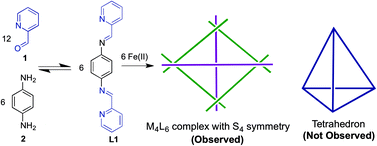Self-assembly of a M4L6 complex with unexpected S4 symmetry†
Abstract
Using 1,4-diaminobenzene and 2-formylpyridine as simple building blocks results in a 1D ligand (rod, L2) to 2D (M4L4 grid, C1) to 3D (S4 symmetrical M4L6, C2) complexes upon sequential addition of Cu(I) and Fe(II) ions. The complex C2 can be seen as the smallest possible pseudo-tetrahedron with S4 symmetry.


 Please wait while we load your content...
Please wait while we load your content...